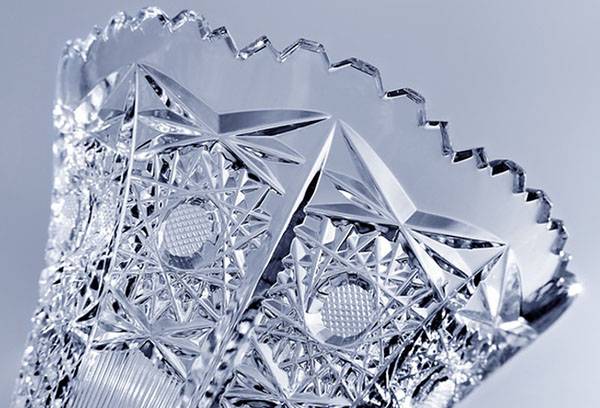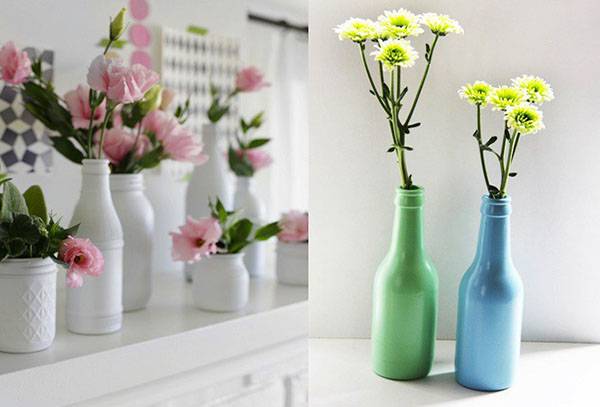Methods for cleaning the vase inside and out
Living bouquets will decorate any room, but when the flowers fade, the question arises, how to wash the vases. If the ceramic vessels are cleaned well enough outside, then in the crystal and glass any internal contamination will be visible. An ugly gray sediment below, rings of lime and rust on the neck immediately give the composition a sloppy look. And if the water has not changed for several days, the smell of rotten liquid can interrupt the aroma of roses and lilies. Do not listen to the claims that, no matter how my vase, it will still be dull. Do not put away the beautiful vessel in the far corner, it is enough to make a little effort, and it will look as if it just came out of the hands of the master.
Crystal and glass cleaning
First you need to wash the vase well from the outside, so that when cleaning the inner surface, you can notice the remaining dirt. Crystal is a whimsical material; if improperly maintained, it becomes dull and loses its luster. It’s much easier to clean the glass, but if mistreated, it will also lose its decorative appearance.
Set aside the soda immediately. Crystal vase should be washed in plain warm water. If the contamination is very strong, it is allowed to use a mild soap solution or mild dishwashing detergent. The corrugated surface at home will be well cleaned with a soft toothbrush. Gently clouded products with coarse salt. Make sure that sharp grains do not scratch the surface. After washing, rinse the items with clean water with a little vinegar or wipe them with an alcoholized cloth and the gloss will restore.
Remember how to wash dishes from transparent materials so that they do not lose their beauty. When washing crystal and decorative glass, follow a few rules.
- At the bottom of the sink or basin, place a soft towel so that the dishes do not break or get scratched.
- Wipe off dust from the product with a dry cloth.
- Avoid temperature extremes. Do not wash the vases in hot or cold water, use liquid at room temperature.
- After washing, thoroughly wipe the vessel so that there are no traces of dried drops.
- If there is a painting or gilding on the vase, any detergent composition should be tried first in an inconspicuous area. If the paint does not fade, you can clean the entire product.
Some dishwashers have crystal wash modes. You can try to clean your vase if the material from which it is made does not contain lead, and when washing, there is no temperature difference expected. Nevertheless, it is better to wash it by hand than risking an expensive product. Spend a few minutes, and the vase will again become clean and shiny.
Tip
If the vessel is very dirty, put it in the water for several hours after boiling the potatoes, and then wash it. The broth should be at room temperature.
Washing ceramics
It is advisable to hold ceramic vases immediately after purchase for several hours in cold water and then rinse with hot water. After this procedure, the glaze will become stronger. Contaminated vessels at home should be washed with hot water and soda. Recesses, pen attachment points, and other areas where dirt is collected can be brushed with a toothbrush or cotton wool wound around a toothpick. After washing the product, rinse it and wipe it dry.
Porcelain and earthenware vases cannot be washed in hot compositions. Use a warm soapy solution. If spots appear on the vase, add some ammonia to the water and rub the contaminated area.
To clean porcelain and faience you can use:
- soda;
- salt;
- vinegar;
- tissue moistened with turpentine.
Narrow-necked vessel cleaning
The hardest thing to clean from plaque is the inner surface of the vase with a narrow neck. If you can still reach the dirty circles on the neck with your finger, a toothbrush or a cloth wound on a pencil, then it is very difficult to find a tool for washing the bottom. The brush does not always reach hard to reach areas, and its hard parts can scratch the vessel.
Hard tools or a cleaning composition with an abrasive effect cannot be used for work. A narrow-necked glass vase can be perfectly cleaned without touching its inner surface. Use one of the methods.
- Pour the vinegar into the vase and leave overnight.
- Pour rice or buckwheat into the vessel to be cleaned, add soda and pour almost the full volume of warm water. Shake the vase vigorously until the dirt is cleaned.
- Take 8 tbsp. tablespoons of warm water, add 2 tbsp. spoons of semolina and 3 tbsp. tablespoons of dry mustard. Rinse the vase with the composition from the inside, and then rinse with a solution of potassium permanganate (0.5 teaspoon in 3 liters of water).
- To wash the green coating of flowers, mix 3 tbsp. tablespoons of rice or buckwheat with 2 tbsp. tablespoons of vodka, pour the composition into the vessel and shake. If the greens do not move away, leave for a few minutes and shake the contents vigorously again.
- Mix in equal parts crushed eggshell and soda. Shake the vase several times, taking breaks for 10-15 minutes.
Be sure to check if the selected product will harm your vase. There are many types of crystal and ceramics, each material in its own way reacts to one or another means. Try cleaning in an inconspicuous area and, if nothing bad has happened, treat the entire vessel. When all the plaque has been cleaned, rinse the vase well and it will look like new.
A vase from any material can be cleaned at home so that there are no traces of salts or green plaque. Remember that the most magnificent bouquet in dirty dishes will lose almost all its charm. The composition should be unified: a tall vessel washed to shine, flowers, accessories. If you properly care for glass, crystal or ceramics, the dishes will last a long time and will not lose their attractive appearance for many years.


